Lipid and Membrane Structure
Lipids and membranes are fundamental components of biological systems, playing critical roles in cellular structure, energy storage, and signaling. Lipids are a diverse group of hydrophobic molecules, while membranes are complex assemblies of lipids and proteins that define the boundaries of cells and organelles. Understanding the structure and function of lipids and membranes using advanced techniques is essential for understanding cellular processes and developing medical and biotechnological applications.
What Is the Structure of Lipids?
Lipids are organic compounds characterized by their hydrophobic nature. They are broadly classified into fatty acids, glycerolipids, glycerophospholipids, sphingolipids, and sterols. The basic building blocks of lipids are fatty acids, which consist of long hydrocarbon chains with a carboxyl group at one end. These chains can be saturated (lacking double bonds) or unsaturated (containing one or more double bonds).
Fatty Acids: These are simple lipids with a carboxylic acid group attached to a hydrocarbon chain. The length of the chain and the degree of unsaturation influence their physical properties and their role in the body.
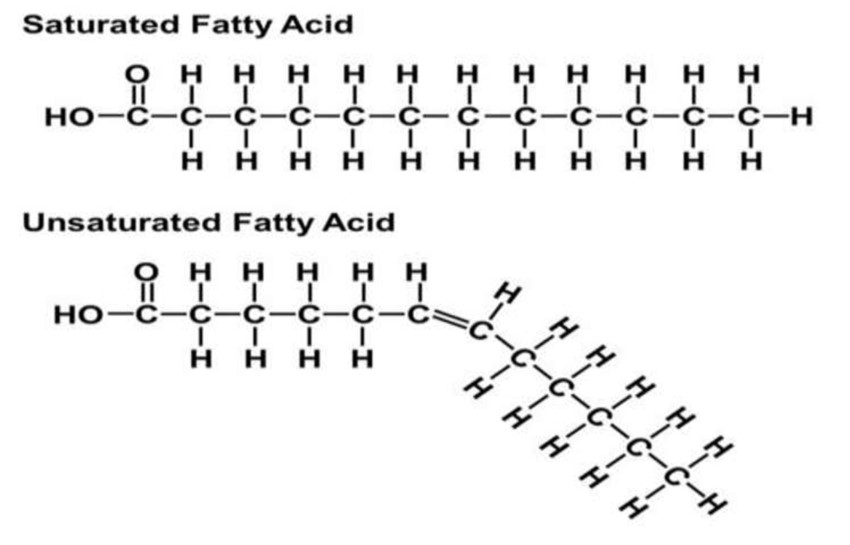 Figure 1. Structure of saturated and unsaturated fatty acids (Oketch, 2022).
Figure 1. Structure of saturated and unsaturated fatty acids (Oketch, 2022).
Glycerolipids: Formed by the esterification of fatty acids to glycerol, they include triglycerides, which are the primary form of stored energy in animals.
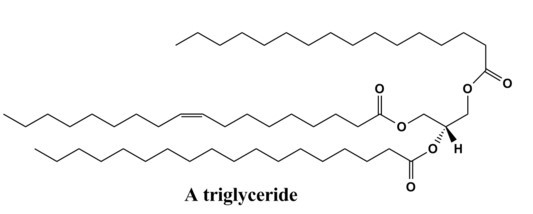 Figure 2. Structure of a triglyceride.
Figure 2. Structure of a triglyceride.
Glycerophospholipids: They are major components of cell membranes. They consist of glycerol, two fatty acids and a phosphate group attached to an additional polar head group. Examples are phosphatidylcholine and phosphatidylethanolamine.
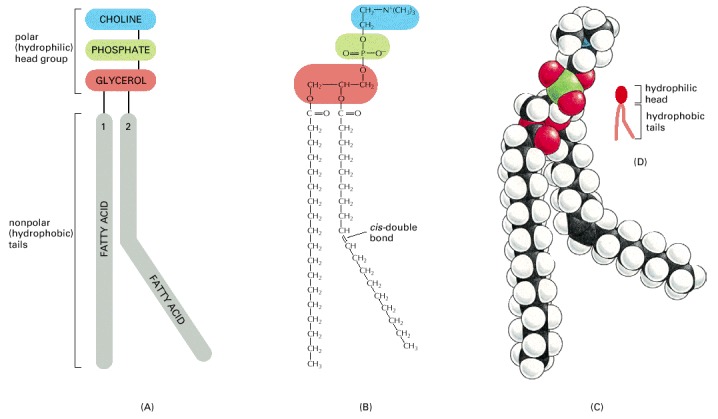 Figure 3. Structure of phosphatidylcholine represented (A) schematically, (B) by a formula, (C) as a space-filling model, and (D) as a symbol (Molecular Biology of the Cell, 4th edition).
Figure 3. Structure of phosphatidylcholine represented (A) schematically, (B) by a formula, (C) as a space-filling model, and (D) as a symbol (Molecular Biology of the Cell, 4th edition).
Sphingolipids: These lipids are derived from sphingosine, an amino alcohol. Sphingomyelin and glycosphingolipids are important in membrane structure and cell signaling.
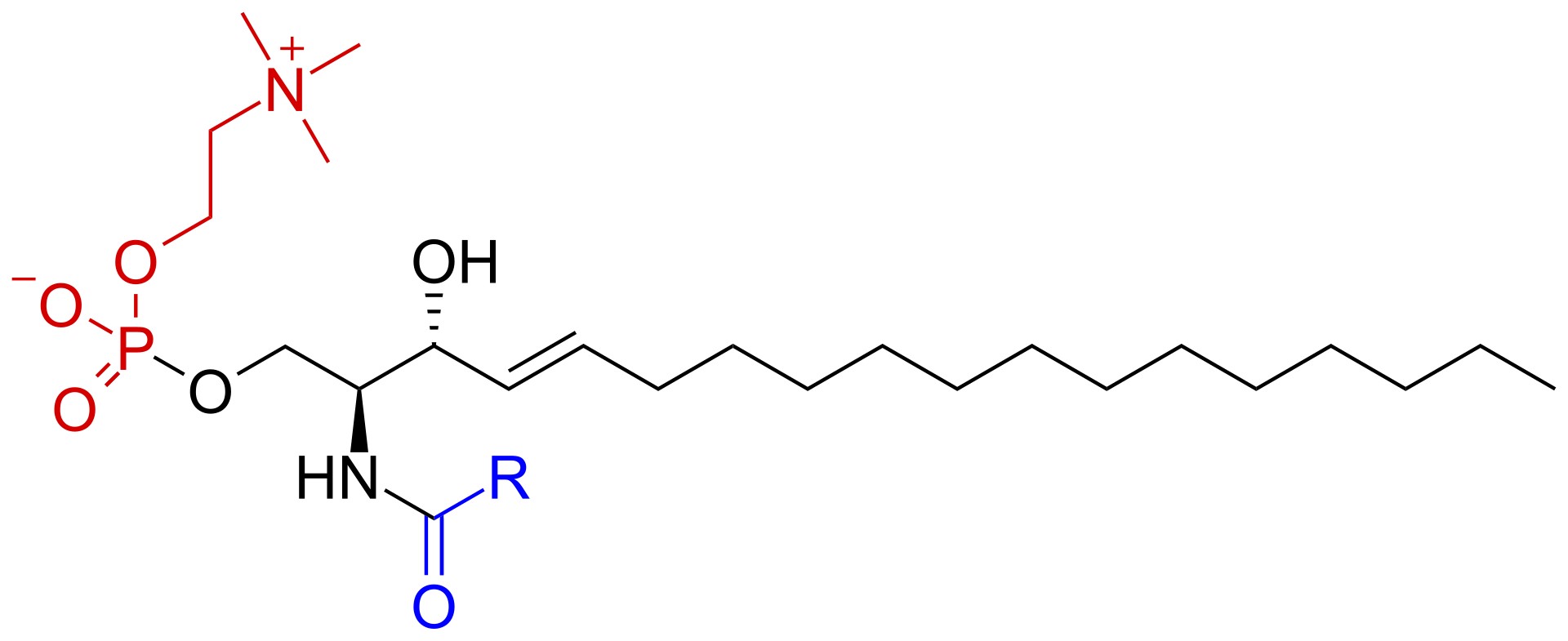 Figure 4. Structure of sphingomyelin.
Figure 4. Structure of sphingomyelin.
Sterols: Cholesterol is the most well-known sterol, essential for membrane fluidity and as a precursor for steroid hormones and bile acids.
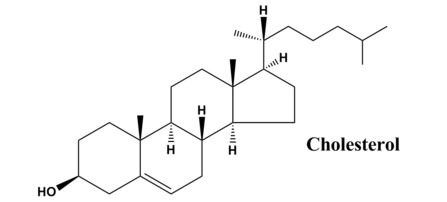 Figure 5. Structure of cholesterol.
Figure 5. Structure of cholesterol.
How Is the Membrane Constructed?
Biological membranes are intricate structures that are essential for cellular function and integrity. They consist primarily of a lipid bilayer interspersed with various proteins, carbohydrates, and other molecules, forming a dynamic and flexible barrier that regulates the passage of substances into and out of the cell. The fluid mosaic model, proposed by Singer and Nicolson in 1972, accurately describes the membrane as a fluid, two-dimensional liquid in which lipids and proteins can move laterally within the layer. This model highlights the versatility and adaptability of the membrane, allowing it to respond to environmental changes and facilitate cellular processes such as communication, transport, and signal transduction.
 Figure 6. Illustration of a cell membrane.
Figure 6. Illustration of a cell membrane.
Lipid Bilayer: The basic structure of the membrane is the lipid bilayer, formed by amphipathic lipids. The hydrophobic tails face inward, away from water, while the hydrophilic heads face outward, interacting with the aqueous environment.
Membrane Proteins: These are integral or peripheral proteins that perform various functions such as transport, signaling, and structural support. Integral proteins span the bilayer, while peripheral proteins associate with the membrane surface.
 Figure 7. Types of membrane proteins (Karki, 2023).
Figure 7. Types of membrane proteins (Karki, 2023).
Carbohydrates: Glycolipids and glycoproteins on the membrane surface play a critical role in cell recognition and signaling. The dynamic nature of membranes allows for the formation of specialized structures such as lipid rafts, which are microdomains enriched in cholesterol and sphingolipids involved in signaling and trafficking.
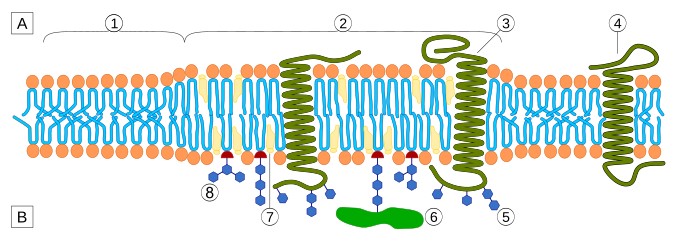 Figure 8. Model of lipid rafts. (A) cytoplasm; (B) extracellular space; (1) normal cell membrane; (2) lipid raft; (3) lipid raft membrane protein; (4) membrane protein; (5) carbohydrate modification of glycoprotein (glycosylation); (6) glycoprotein linked by Glycosylphosphatidylinositol anchor; (7) cholesterol; (8) carbohydrate modification of a glycolipid.
Figure 8. Model of lipid rafts. (A) cytoplasm; (B) extracellular space; (1) normal cell membrane; (2) lipid raft; (3) lipid raft membrane protein; (4) membrane protein; (5) carbohydrate modification of glycoprotein (glycosylation); (6) glycoprotein linked by Glycosylphosphatidylinositol anchor; (7) cholesterol; (8) carbohydrate modification of a glycolipid.
Physiological Roles of Lipids and Membranes
Lipids and membranes perform several vital functions in biological systems:
Energy Storage: Triglycerides stored in adipose tissue serve as a major energy reserve, providing more than twice the energy per gram compared to carbohydrates and proteins.
Structural Components: Lipids are essential for the integrity and functionality of cell membranes, providing a barrier that separates the intracellular environment from the extracellular space.
Signaling Molecules: Lipids such as steroid hormones, eicosanoids, and phosphoinositides are critical in signaling pathways that regulate various physiological processes.
Insulation and Protection: Lipids such as the myelin sheath in nerve cells provide insulation, while others form protective barriers in the skin.
Membrane Fluidity and Function: Cholesterol and unsaturated fatty acids regulate membrane fluidity, influencing membrane protein activity and cell functionality.
Methods for Analyzing of Lipids and Membranes
Lipids are extracted from complex biological samples, including tissues, cells and body fluids, using organic solvent extraction and solid phase extraction (SPE). After extraction, the lipids are analyzed using a variety of techniques, including mass spectrometry (MS), nuclear magnetic resonance (NMR) spectroscopy, cryo-electron microscopy (cryo-EM), and others to study lipid and membrane structures. Detailed methods and characteristics determined are summarized in the table below.
| Techniques | Description |
| Thin-layer chromatography (TLC) | TLC is used to separate complex lipid mixtures into different lipid classes. The separation is based on the relative affinity of compounds for the two phases. |
| Mass Spectrometry (MS) | MS is a powerful tool for lipidomics, providing detailed information on lipid species, their abundance, and modifications. |
| Nuclear Magnetic Resonance (NMR) Spectroscopy | NMR is used to determine the structure and dynamics of lipids and membrane proteins in their native environment. |
| Cryo-Electron Microscopy (Cryo-EM) | Cryo-EM allows for high-resolution imaging of membrane proteins and complexes in a near-native state. |
| X-ray Crystallography | X-ray crystallography provides atomic-level details of the structures of membrane proteins, aiding in the understanding of their function. |
| Fluorescence Spectroscopy | Fluorescence spectroscopy such as Fluorescence Recovery After Photobleaching (FRAP) and Förster Resonance Energy Transfer (FRET) used to study membrane dynamics, lipid diffusion, and protein-lipid interactions by labeling with fluorescent probes. |
| Atomic Force Microscopy (AFM) | AFM provides high-resolution images of membrane surface topography and is used to study the morphology of lipid bilayers, membrane proteins, and the mechanical properties of membranes. |
| Electron Paramagnetic Resonance (EPR) Spectroscopy | EPR probes the dynamics, organization, and environment of membrane lipids and proteins. EPR detects the behavior of unpaired electrons in spin-labeled molecules within the membrane, providing insights into lipid dynamics and protein-lipid interactions. |
| Differential Scanning Calorimetry (DSC) | DSC measures the thermal properties of lipid bilayers and detects changes in heat capacity as the membrane is heated or cooled, providing information on phase transitions (e.g., from gel to liquid crystalline state). |
Applications of Studying Lipid and Membrane Structure
Understanding lipid and membrane structures has many applications in science and medicine:
Drug Delivery: Advances in the understanding of lipid and membrane structures have revolutionized drug delivery systems. Liposomes, spherical vesicles with a lipid bilayer, can encapsulate drugs, increasing their stability and bioavailability. These lipid-based nanoparticles can be engineered to target specific tissues, reducing side effects and increasing therapeutic efficacy.
Disease Diagnosis and Treatment: Abnormal lipid metabolism is associated with diseases such as cardiovascular disease, obesity and cancer. The study of lipid profiles aids in the diagnosis and development of therapeutic strategies.
Nutrition and Health: Dietary lipids influence health, and studying their effects on membrane composition and function can inform nutritional recommendations and interventions.
Environmental Science: Lipid analysis in microorganisms helps to understand their role in biogeochemical cycles and environmental adaptation.
Synthetic Biology: Engineered lipid membranes can be used to create artificial cells and systems for research and industrial applications.
Lipids and membranes are indispensable to life, playing critical roles in cellular structure, energy storage, and signaling. Advances in analytical techniques have enhanced our understanding of their complex structures and functions, opening new avenues for research and applications in medicine, biotechnology, and environmental science.
At Creative Biostructure, we specialize in lipid and membrane structure-related assay services, providing comprehensive analysis and innovative solutions. Our expertise enables advanced research and biotechnology applications, driving breakthroughs and accelerating scientific discovery. If you have specific needs or would like more information about our services, please contact us. Our team is here to help you find the best solutions to meet your research and development goals.
References
- Molecular Biology of the Cell, 4th edition.
- Karki, P. (2023). Membrane proteins: Structure, types, functions. Microbe Notes. https://microbenotes.com/membrane-proteins-definition-structure-types-functions/
- Lu, Y., Allegri, G., & Huskens, J. (2022). Vesicle-based artificial cells: Materials, construction methods and applications. Materials Horizons, 9(3), 892–907.
- Oketch, Elijah. (2022). Physiological responses of broiler chickens to exogenous emulsifier supplementation in tallow-incorporated reduced-energy diets.
- Pati, S., Nie, B., Arnold, R. D., & Cummings, B. S. (2016). Extraction, chromatographic and mass spectrometric methods for lipid analysis. Biomedical Chromatography: BMC, 30(5), 695–709.
- Villalba, N., Baby, S., & Yuan, S. Y. (2021). The endothelial glycocalyx as a double-edged sword in microvascular homeostasis and pathogenesis. Frontiers in Cell and Developmental Biology, 9, 711003.
